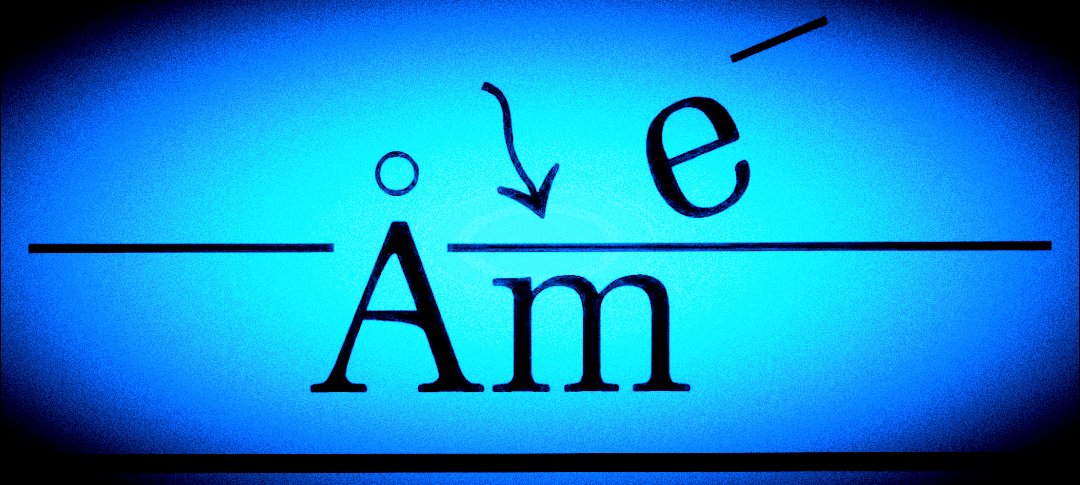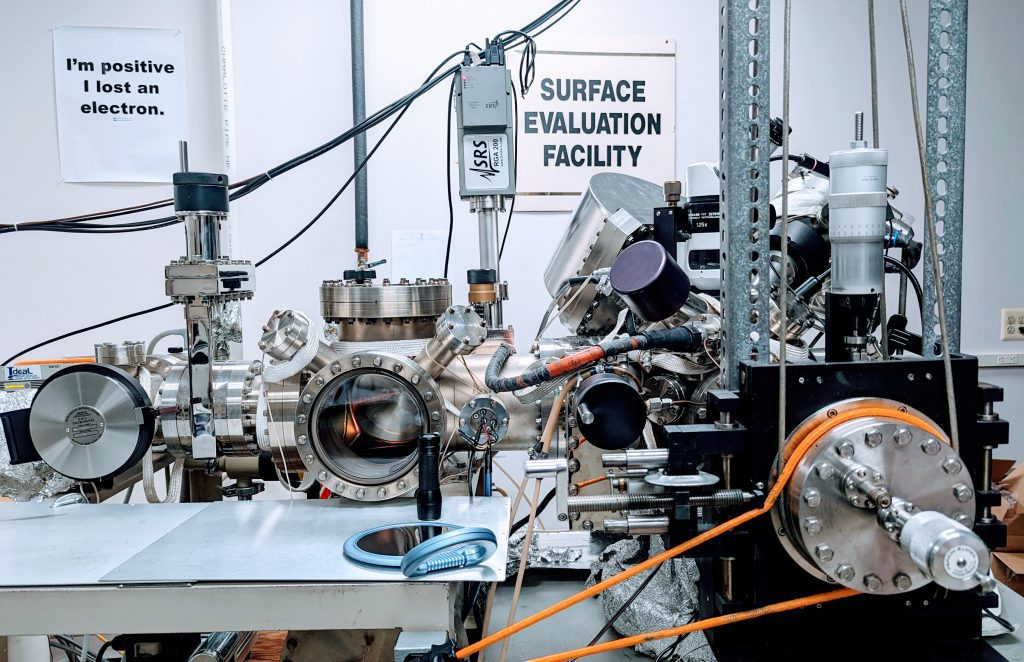Anderson Materials Evaluation, Inc. can determine the elemental composition of a wide range of materials using several different and complementary quantitative analytical spectroscopies:
- X-ray Photoelectron Spectroscopy (XPS or ESCA)
- Energy Dispersive X-ray Spectroscopy (EDX or EDS)
- Wavelength Dispersive X-ray Fluorescence Spectroscopy (WD XRF)
- Laser-Induced Breakdown Spectroscopy (LIBS)
When making a decision about which technique to use for a given elemental composition analysis, it is important to bear in mind these essential characteristics of each technique:
- Depth of analysis
- Area of analysis
- Which elements can be detected
- How quantitative are the results for given elements
- What are the detection limits for a given element
In these respects, our several elemental analysis capabilities are complementary.
XPS or ESCA for Elemental Composition Analysis
- The analyzed depth is a very surface-sensitive depth of about 10 nm. A quantitative elemental composition analysis with this strong a sensitivity to the surface is extraordinarily important in obtaining highly quantitative measurements of surface contamination, causes of adhesive bonding problems or thin film delamination problems, issues relating to surface reactions and the initiation of corrosion problems, the characterization of surface oxides and other surface treatments, the segregation of some elements to a surface in a metal alloy, the operation of catalysts, electrical contact issues, and many more technological problems. But, while the surface composition of many fully reacted materials may be very nearly the same as the bulk composition, it also is very different in many materials.
- The area of analysis is an ellipse, when samples are mounted in the usual way, of variable size, but the most common size has a major axis of 1200 nm and a minor axis of 600 nm. 600 x 300 nm and 300 x 150 nm are also available, but the signal strength drops considerably upon using smaller areas.
- In many cases, a material can be argon ion beam etched to provide quantitative elemental composition results as a function of depth from the surface. Some materials, such as many polymers, are too fragile to perform ion beam etching on without decomposing them. But this technique is very useful with metal alloys and oxides, semiconductor materials, and many glass, ceramic, inorganic, and mineral materials.
- XPS allows the quantitative measurement of all the elements except hydrogen and helium. There are cases in which two elements have overlapping photoelectron peaks and this may degrade the quantitative accuracy of the analysis. Other non-overlapping peaks for the same elements may offer an alternative accurate analysis.
- The XPS quantitative analysis of the material at the surface is highly quantitative except in those cases when the composition varies strongly in the outer 10 nm of the surface. It tends to be more accurate quantitatively than EDX or EDS is when the surface chemistry is the same as the bulk chemistry. This is an important qualification and one needs to understand when the surface chemistry and the bulk chemistry are likely to be the same or different.
- XPS can provide a separate quantitative elemental analysis for each of two or three chemical phases occupying the analysis area when high energy resolution spectra for the elements present are also acquired. EDX will only provide an average elemental composition in the volume it analyzes, though that volume is commonly about 1000 to 2000 times smaller. In most cases, XPS analysis samples many particles or many grains in a polycrystalline material, while EDX analysis may sample only one particle or one grain. EDX analysis may require many more sets of data to achieve an accurate average simply due to local sample inhomogeneity.
- XPS analysis works well on insulating materials, as well as on conducting or semiconducting materials. This avoids conductive coating interference problems that may accompany EDX analysis.
EDS for Elemental Composition Analysis
- The analysis depth is commonly about 1000 to 2000 nm, or 100 to 200 times deeper than is the case for XPS analysis.
- Due to subsurface scattering of the electron beam, the analyzed volume is shaped like a Florence flask with the narrow neck shortened and reaching down into the bulk material before bulging out into the somewhat spherical subsurface volume from which most of the elemental composition data comes. The lateral dimensions tend to be about 2000 nm in the subsurface volume from which most of the signal comes. One can raster the electron beam and obtain the average composition over larger areas, which can relieve the problem of getting accurate average results when all the signal with a point analysis might come from a single particle or metallic grain.
- Our EDX detects all elements from carbon and heavier elements. The quantitative results for carbon, nitrogen, oxygen, fluorine, neon, and sodium progressively improve as the element becomes heavier. Hydrogen, helium, lithium, beryllium, and boron are not detected with our EDX. Lithium, beryllium, and boron are detected and can be quantitatively analyzed with XPS. The XPS accuracy of analysis for carbon, nitrogen, and oxygen is very high, while it is abysmal for EDX .
- The quantitative analysis changes as the electron beam energy is changed, since the scattering depth and lateral range change and change differently in different materials. The most accurate quantitative analysis is obtained when using standard materials similar to the material to be analyzed.
- Because of the charged excitation electron beam, rather than neutral x-rays used in XPS analysis, EDX analysis on some insulating materials is challenging and may be of much reduced usefulness. The volume of analysis may have to be much larger to get useful data. One can raster the electron beam over a very large area and acquire the x-ray spectrum from that large area since less charge is built-up in the smaller fraction of the time the electron beam is being dumped into a given volume of material. The charge developed by the absorption of the electron beam may cause ionic migration in the material which may also affect the analysis.
- If one is trying to identify which metal alloy a metal is, EDX is usually much preferred to XPS because some elements in the metal may have a strong preference to segregate to the surface to bond with oxygen, carbon dioxide, or water vapor; or because its surface energy is less than its lattice energy, or due to prior heat treatment of the alloy. The greater depth of analysis with EDX is very helpful in this case, though even when using EDX the surface needs to be cleaned, polished, and cleaned before analysis to establish the metal alloy.
WD XRF Analysis
- The analysis depth is commonly about 3000 nm, or 150 times deeper than is the case for XPS analysis and about twice that of EDX analysis. Heavy elements are generally seen from much greater depths than are light elements.
- Areas of 29 mm, 10 mm, 1.5 mm, and 0.5 mm diameter can be analyzed with our XRF.
- Our spectrometer detects all elements from fluorine, sodium and heavier through uranium with excellent quantitative accuracy. It can also detect carbon and nitrogen, but this capability is best utilized with polymers and low density samples, since otherwise the sampling depth is very shallow. It will not detect and measure boron, beryllium, and lithium, so turn to XPS analysis for those light elements.
- Our XRF spectrometer has lower weight percentage detection limits for every element it can detect than does EDX. XPS may detect a smaller number of atoms of a light element, but will not match XRF in detecting ppm in the bulk of a material of heavier elements.
- XRF is the best way to determine the composition of a metal alloy or to identify a metal alloy by its composition, provided the material presents enough area and depth for the measurement. For small areas, EDS is best and for very thin layers, XPS is best.
- Our XRF can analyze liquids for detectable elements using a helium atmosphere, which XPS and EDX cannot do since they operate under vacuum.
- XRF is widely used to determine the composition of concrete and mortar, mineral, glass, ceramic, oil, water, and soil materials.
- Used to determine RoHS compliance for the following: lead, mercury, cadmium, hexavalent chromium, polybrominated biphenyls (PBB) and polybrominated diphenyl ethers (PBDE).
- Used to detect low concentration impurities in drugs and food.
LIBS Analysis
- Allows small volume analysis, typically 10 micrometers in diameter and 5 – 7 micrometers deep with laser ablation to create a plasma whose characteristic elemental optical emissions are measured
- Detects and measures all elements H, Li, Be, B, C, N, O, F, Na, Mg, Al, Si, P, S, and heavier through U.
- Integrated with Keyence 4K Digital Microscope with 3D Images at magnifications from 20X to 2000X
- Can provide single laser pulse analysis, depth profile at one location using multiple pulses, or multiple site analysis with a single laser pulse
- LIBS is not highly quantitative and it often has problems detecting halogen elements in ionic compounds
It is often a good idea to contact us to determine which analysis is most useful for a particular materials characterization or problem-solving task. In most cases, one of these techniques will provide useful and even essential information for your elemental composition analysis needs.


